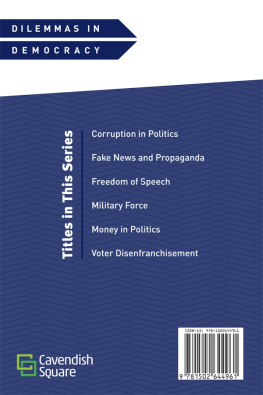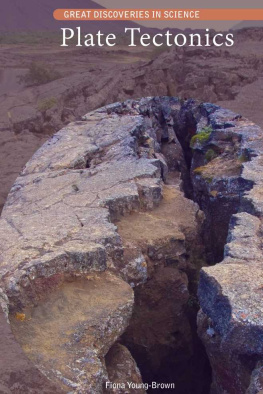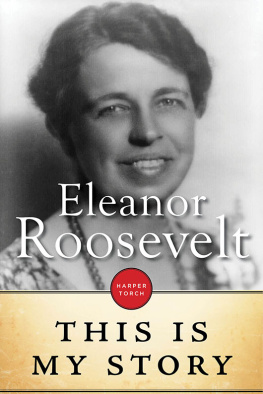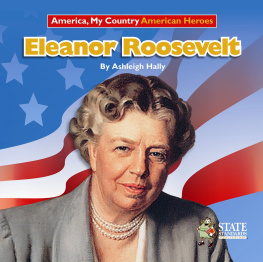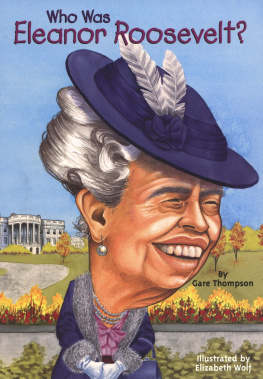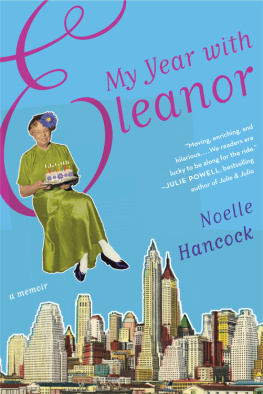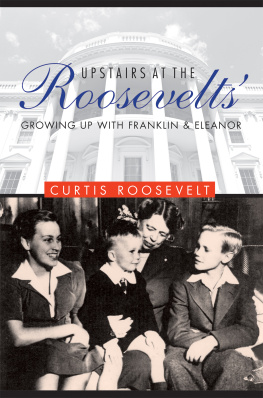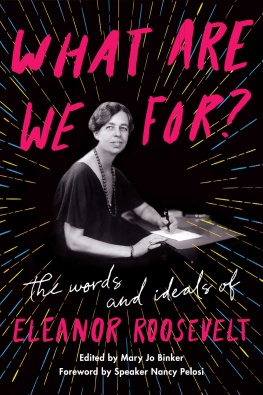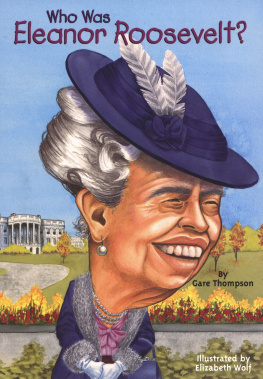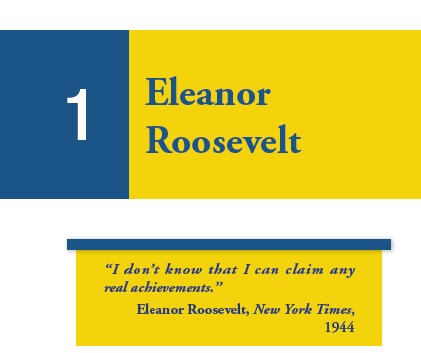Published in 2018 by Cavendish Square Publishing, LLC
243 5th Avenue, Suite 136, New York, NY 10016
Copyright 2018 by Cavendish Square Publishing, LLC First Edition
No part of this publication may be reproduced, stored in a retrieval system, or transmitted in any form or by any means electronic, mechanical, photocopying, recording, or otherwisewithout the prior permission of the copyright owner. Request for permission should be addressed to Permissions, Cavendish Square Publishing, 243 5th Avenue,
Suite 136, New York, NY 10016. Tel (877) 980-4450; fax (877) 980-4454.
Website: cavendishsq.com
This publication represents the opinions and views of the author based on his or her personal experience, knowledge, and research. The information in this book serves as a general guide only. The author and publisher have used their best efforts in preparing this book and disclaim liability rising directly or indirectly from the use and application of this book.
All websites were available and accurate when this book was sent to press.
Library of Congress Cataloging-in-Publication Data
Names: Young-Brown, Fiona, author.
Title: Eleanor Roosevelt : first lady / Fiona Young-Brown.
Description: New York : Cavendish Square Publishing, [2018] |
Series: History makers | Includes bibliographical references and index.
Identifiers: LCCN 2017019557 (print) | LCCN 2017020171 (ebook) |
ISBN 9781502633231 (E-book) | ISBN 9781502632944 (library bound)
Subjects: LCSH: Roosevelt, Eleanor, 1884-1962--Juvenile literature. |
Presidents spouses--United States--Biography--Juvenile literature.
Classification: LCC E807.1.R48 (ebook) I LCC E807.1.R48 Y65 2018 (print) I DDC 973.917092 [B] --dc23 LC record available at https://lccn.loc.gov/2017019557
Editorial Director: David McNamara Editor: Kristen Susienka Copy Editor: Rebecca Rohan Associate Art Director: Amy Greenan Designer: Jessica Nevins Production Coordinator: Karol Szymczuk Photo Research: J8 Media
The photographs in this book are used by permission and through the courtesy of: Cover, p 1 IanDagnall Computing/Alamy Stock Photo; p. 4 Science History Images/Photo Researchers/Alamy Stock Photo; p. 6 Fotosearch/Archive Images/Getty Images; p. 8, 98 Everett Historical/Shutterstock.com; p. 10-11, 16-17, 55, 60-61, 76-77, 82-83, 90-91, 119 Bettmann/ Getty Images; p. 14 Hulton Archive/Getty Images; p. 23, 31 Franklin D. Roosevelt Presidential Library & Museum; p. 26 Oscar Jordan/Wikimedia Commons/File:Eleanor-Franklin-Roosevelt-August-1932.jpg/CC BY-SA 2.0; p. 36-37, 104-105 PhotoQuest/Getty Images; p. 40, 86, 116 Everett Collection/Alamy Stock Photo; p. 46 Charles Phelps Cushing/ClassicStock/Alamy Stock Photo; p. 49 National Archives and Records Administration/Wikimedia Commons/ File:Eleanor Roosevelt, Marian Dickerman, and Nancy Cook in Campobello - NARA - 195627.tif/CC PD; p. 52 Lebrecht Music and Arts Photo Library/Alamy Stock Photo; p. 66-67 Hulton-Deutsch Collection/Corbis Historical/Getty Images; p. 68 National Archives and Records Administration/Wikimedia Commons/File:Eleanor Roosevelt in Galapagos Island - NARA - 196623.jpg/CC PD; p. 70 Stock Montage/Archive Photos/Getty Images; p. 95 National Park Service; p. 100 Corbis Historical/Getty Images; p. 103 Oscar White/Corbis Historical/VCG via Getty Images; p. 109 National Archives and Records Administration/Wikimedia Commons/File:Eleanor Roosevelt at United Nations meeting in London, England - NARA -195961.jpg/CC PD; p. 114 Lisa Larsen/The LIFE Picture Collection/Getty Images; p. 121 Keystone-France/Gamma-Rapho via Getty Images; p. 127 C. M. de Talleyrand-Peirgord/Wikimedia Commons/File:Riverside Drive at 72nd Street.jpg/CC BY-SA 3.0; p. 128 National Archives and Records Administration/Wikimedia Commons/File:Eleanor Roosevelt and Fala at Val,Kill in Hyde Park, New York - NARA - 196181.jpg.
Printed in the United States of America
I don't remember when I first became aware of Eleanor Roosevelt. To be fair, I grew up in the United Kingdom in the 1980s, which gave me the benefit of seeing women in roles of political leadership. It also made me aware of the double standard to which those women were exposed. If they appeared too outspoken or strong, they were mocked, called into question as women.
I learned some American history and went on to study it at university. By then, I was more than aware of Eleanor. I realized that in my mind the idea of Franklin Roosevelt did not, could not, exist without Eleanor. They were forever linked. It is impossible to talk about one without mentioning the other. More than just husband and wife, they were a partnership of ideals. He reined her in by being ever mindful of what was politically possible while also encouraging her to see, experience, bring him the truths and potential of the outside world. For her part, Eleanor continually pushed Franklin to consider the world beyond the insular society of Washington, DC. To think about what could be achieved.
Opposite : This painting of Eleanor Roosevelt, the United States longest-serving First Lady, was done by Douglas Chandor.
But, just as I saw happen to the female leaders of my childhood, and as I have seen happen to many since, Eleanor was someone who was mocked, criticized, questioned. Her appearance wasn't satisfactory. Her voice was wrong. Her demeanor wasn't what it should be. In short, she challenged what it meant to be a woman and a wife.
In 1932, the New York Times Magazine stated: The President's wife must be a silent partner. The unwritten law is that the First Lady gives no interviews, [and] makes no public statements.
In the case of Eleanor Roosevelt, nothing could be further from the truth. As the longest-serving First Lady, she wrote books and a daily newspaper column; she gave regular radio addresses; she traveled the country and the world giving speeches. While some continued to criticize her for it, most loved her. Today, decades after her death, she continues to be voted one of the most influential figures in American history.
Opposite: Franklin and Eleanor Roosevelt celebrate after the 1941 presidential inauguration ceremony.
Eleanor Roosevelt was born into a family that had been in the United States since their Dutch immigrant ancestor first arrived in what is now New York in the seventeenth century. By the time of her birth, the Roosevelts were a powerful and wealthy extended family, known in both business and politics. Her uncle was President Theodore Roosevelt. She grew up in a cocoon of wealth and expectation, but also isolation. Her father was the black sheep of the family, battling alcoholism until the day he died. Her mother was distant, beautiful, and elegant but struggling to balance social conventions with an unhappy marriage. In a world where women were valued for their looks, the young Eleanor disappointed, as her mother never hesitated to remind her.


